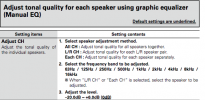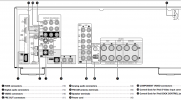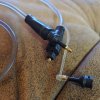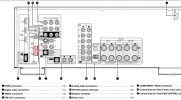Hello, I am new on this forum and to audio equipment in general. I will try to be concise. I have done a bit of reading here and there and am working to familiarize myself with vocabulary and general concepts. As most reading this likely know it is a real rabbit hole.
I have always enjoyed going to live shows and appreciating a variety of music. I have seen a lot of live music shows hosting Funktion 1 sound systems that led me down a path of enjoying music and sound. Recently I bought my first home system. I am a novice and my equipment is limited but I am wanting to learn more and optimize it.
Currently I am running a pair of Canton Chrono 70 speakers which I purchased used. I am running them with a Denon AVR-590 receiver that someone gave to me a while ago. My room is somewhere between 250-300 square feet, have not measured it exactly. I primarily use wifi to play music from my phone through a Google Chromecast Audio connected through aux to my AVR. I am mostly interested in listening to music with my system but if eventually I can use it for movies too then that would be a welcome addition although not really a priority of mine. Eventually I intend to add a subwoofer as much of the music I listen to has complex bass that I enjoy. I have read about the SVS SB-1000 pro and think it would be good eventually for my budget and needs.
My question currently is regarding my receiver/amplifier. It is somewhat clear to me that my AVR is limiting me from getting the full experience from my speakers. They are the first speakers I have owned other than a small bluetooth speaker so really they sound amazing to me but I know that they could sound better. My issue is that there is just so much information out there regarding receivers/AVRs/stereo amplifiers/etc. that I am somewhat overwhelmed regarding where to start. I have read through this thread (https://www.audiosciencereview.com/...-stereo-amplifier-with-bass-management.22583/) regarding comparing stereo amplifiers and AVRs as it pertains to bass specifically and found information within that thread to be informative though still unclear regarding some things.
Can someone either recommend a receiver or provide perspective on where I should begin to identify what might work for my situation? I am somewhat limited on funds for more equipment currently so could either spend between $300-$500 now or wait until I have saved more in the future if that is what would be the most logical path forward. Below are the questions I currently have specifically:
1. My understanding is that the benefit of an AVR beyond the video support component is the various features such as having crossover frequency support which will be useful when I have a subwoofer, and the "room correction" settings. Is this accurate? Can these things also be gathered from a stereo amplifier and another piece of equipment in a cohesive and approachable (cost/learning curve) manner?
2. Is there any benefit to having a stereo amplifier instead of an AVR? I know this is a common question/debate so if needed I can try searching through older posts. I do not intend to run surround sound so for now am planning to just run my two speakers and a subwoofer (when I can purchase one).
3. Someone on a subreddit that I posted this question on suggested that I get a stereo amplifier that can drive 100watts per channel, and to be sure that it is rated to 4 ohms (they said this as they viewed my Canton speakers as being "inefficient", meaning that they need more power and are rated at 4ohms. Does this sound right?
4. I also understand that having some way to EQ my speakers, as well as having settings for crossover frequency will be important once I have a subwoofer. Is this accurate?
5. Is my Denon AVR-590 safe to run my speakers with for the time being? It reads as being rated for 6 or 8ohms (if I am reading the manual correctly) and my speakers are listed as 4-8ohms (I think). I have been running them for a month or so with this Denon and they sound fine and quite capable.
6. When my current Denon was given to me it did not have the microphone with it, so I have not done the Audyssey room correction setup on it. Currently the only settings I have are for the speakers to be set to Large due to me not having a subwoofer, and I have the distance set between the speakers and my listening position. Would it be worth ordering a replacement microphone to go through the Audyssey EQ setup for the time that I am using the Denon that I have?
7. With these things in mind, can anyone provide perspective regarding what type of receiver I should begin looking at? Or perhaps my current Denon is capable I just need to use the settings more effectively? (such as through the Audyssey EQ)
Any and all help or perspective is greatly appreciated. I know I have asked lots of questions, so even having one or two answered would be helpful to me. I have really enjoyed learning so far and am looking forward to knowing more. I am glad to have found this forum. Thanks.
I have always enjoyed going to live shows and appreciating a variety of music. I have seen a lot of live music shows hosting Funktion 1 sound systems that led me down a path of enjoying music and sound. Recently I bought my first home system. I am a novice and my equipment is limited but I am wanting to learn more and optimize it.
Currently I am running a pair of Canton Chrono 70 speakers which I purchased used. I am running them with a Denon AVR-590 receiver that someone gave to me a while ago. My room is somewhere between 250-300 square feet, have not measured it exactly. I primarily use wifi to play music from my phone through a Google Chromecast Audio connected through aux to my AVR. I am mostly interested in listening to music with my system but if eventually I can use it for movies too then that would be a welcome addition although not really a priority of mine. Eventually I intend to add a subwoofer as much of the music I listen to has complex bass that I enjoy. I have read about the SVS SB-1000 pro and think it would be good eventually for my budget and needs.
My question currently is regarding my receiver/amplifier. It is somewhat clear to me that my AVR is limiting me from getting the full experience from my speakers. They are the first speakers I have owned other than a small bluetooth speaker so really they sound amazing to me but I know that they could sound better. My issue is that there is just so much information out there regarding receivers/AVRs/stereo amplifiers/etc. that I am somewhat overwhelmed regarding where to start. I have read through this thread (https://www.audiosciencereview.com/...-stereo-amplifier-with-bass-management.22583/) regarding comparing stereo amplifiers and AVRs as it pertains to bass specifically and found information within that thread to be informative though still unclear regarding some things.
Can someone either recommend a receiver or provide perspective on where I should begin to identify what might work for my situation? I am somewhat limited on funds for more equipment currently so could either spend between $300-$500 now or wait until I have saved more in the future if that is what would be the most logical path forward. Below are the questions I currently have specifically:
1. My understanding is that the benefit of an AVR beyond the video support component is the various features such as having crossover frequency support which will be useful when I have a subwoofer, and the "room correction" settings. Is this accurate? Can these things also be gathered from a stereo amplifier and another piece of equipment in a cohesive and approachable (cost/learning curve) manner?
2. Is there any benefit to having a stereo amplifier instead of an AVR? I know this is a common question/debate so if needed I can try searching through older posts. I do not intend to run surround sound so for now am planning to just run my two speakers and a subwoofer (when I can purchase one).
3. Someone on a subreddit that I posted this question on suggested that I get a stereo amplifier that can drive 100watts per channel, and to be sure that it is rated to 4 ohms (they said this as they viewed my Canton speakers as being "inefficient", meaning that they need more power and are rated at 4ohms. Does this sound right?
4. I also understand that having some way to EQ my speakers, as well as having settings for crossover frequency will be important once I have a subwoofer. Is this accurate?
5. Is my Denon AVR-590 safe to run my speakers with for the time being? It reads as being rated for 6 or 8ohms (if I am reading the manual correctly) and my speakers are listed as 4-8ohms (I think). I have been running them for a month or so with this Denon and they sound fine and quite capable.
6. When my current Denon was given to me it did not have the microphone with it, so I have not done the Audyssey room correction setup on it. Currently the only settings I have are for the speakers to be set to Large due to me not having a subwoofer, and I have the distance set between the speakers and my listening position. Would it be worth ordering a replacement microphone to go through the Audyssey EQ setup for the time that I am using the Denon that I have?
7. With these things in mind, can anyone provide perspective regarding what type of receiver I should begin looking at? Or perhaps my current Denon is capable I just need to use the settings more effectively? (such as through the Audyssey EQ)
Any and all help or perspective is greatly appreciated. I know I have asked lots of questions, so even having one or two answered would be helpful to me. I have really enjoyed learning so far and am looking forward to knowing more. I am glad to have found this forum. Thanks.





